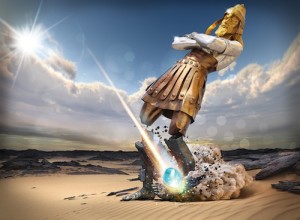
The statue of Nebuchadnezzar’s dream, as depicted in Daniel chapter 2, has been the object of considerable study and speculation since Daniel first understood and revealed the dream. The statue represents four kingdoms that will come upon the earth, beginning with, and including, Nebuchadnezzar’s (Daniel 2:37-40). The “head was of fine gold, his breast and his arms of silver, his belly and his thighs of brass, His legs of iron, his feet part of iron and part of clay” (Daniel 2:22-32). These represented the current and coming world empires—Babylon, Medo-Persia, Greece, and Rome. As Daniel explains, the fourth kingdom starts with the strength of iron, but its Feet and Toes are part iron and part clay, which is to signify that the once strong kingdom “shall be divided” but with “the strength of the iron” (Daniel 2:41). In this vision, a stone carved without hands “smote the image upon his feet that were of iron and clay” (Daniel 2:34) and “it brake in pieces the iron, the brass, the clay, the silver, and the gold” (Daniel 2:45). As Daniel explains, the meaning of the stone is that “in the days of these kings shall the God of heaven set up a kingdom, which shall never be destroyed” (Daniel 2:44). Continue reading The Fifth Empire (part 1)
 Follow
Follow

